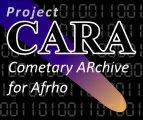



Copyright © All rights reserved. Made By Erik Bryssinck Terms of use | Privacy policy














|
Observation date |
image |
Photometry (FOCAS) |
Afρ |
astrometry |
Observatory |
|
X |
|
|
X |
B96 - |
|
|
|
|
|
|
|
|
|
|
|
|
|
|
|
|
|
|
|
|
|
|
|
|
|
|
|
|
|
|
|
|
|
|
|
|
|
|
|
|
|
|
|
|
|
|
|
|
|
|
|
|
|
|
|
|
|
|
|
|
|
|
|
|
|
|
|
|
|
|
|
Comet P/2019 LM4 (PALOMAR)
Photometric data obtained from FOCAS-
COD X02
OBS Telescope.Live Observatory
CATALOG: Gaia DR2 -
10x10 20x20 30x30 40x40 50x50 60x60 SNR SB COD
COMET UTC +/-
-
AFRHO LOG
COMET UTC DELTA r BOX " MAG RSR CM +/-
-
C/2020 J1 Orbital elements not found
FoCAs 3.66
www.astrosurf.com/cometas-
es.groups.yahoo.com/group/Cometas_Obs
Af(rho) data according the CARA-

COMET P/2019 LM_4 (PALOMAR)
An apparently asteroidal object discovered on images taken at Palomar on 2019 June 4 and 7 with the 1.2-
B. Li reported the discovery by G. Zhaori of an extended object on images taken by L. F. Hu with the 1.04-
3".6 compared to 1".2 for nearby stars. .....